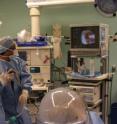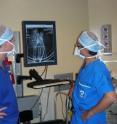Gene therapy repairs injured human donor lungs for the first time
For the first time, scientists in the McEwen Centre for Regenerative Medicine, University Health Network have successfully used gene therapy to repair injured human donor lungs, making them potentially suitable for transplantation into patients. This technique could significantly expand the number of donor lungs by using organs that are currently discarded, and improve outcomes after transplantation. In their pioneering work, a team of researchers led by Dr. Shaf Keshavjee, Senior Scientist at the McEwen Centre for Regenerative Medicine, University Health Network and Director of the Lung Transplant Program, University Health Network developed a technique of ex vivo gene delivery to donor lungs, before they are implanted into a recipient's body. The technique was shown to be simple and effective in improving lung function. Their results, "Functional Repair of Human Donor Lungs by IL-10 Gene Therapy," are published in the October 28, 2009 edition of the journal Science Translational Medicine: http://stm.sciencemag.org/
"This work is a big step in using regenerative strategies to repair injured lungs," says Dr. Keshavjee, who is also Director, Latner Thoracic Research Laboratories and Professor and Chair, Division of Thoracic Surgery at the University of Toronto. "For the first time, we hope to improve the health of donor lungs that we could not have used before by using gene therapy to decrease inflammation and repair cells before transplantation."
Dr. Keshavjee also emphasizes that clinical trials on humans would be the next step in testing this promising approach before it could be used on patients waiting for lung transplants. In these future clinical trials, lungs repaired with the gene therapy will be offered to patients waiting for a life-saving lung transplant. The process of gene therapy used on injured lungs will be carefully explained to the patients and, if they consent, the patients will be potentially transplanted with the repaired lungs should no other suitable donor lungs become available. "This work opens the door for a variety of therapies that could potentially be applied to repair various injuries in other donor organs to improve the safety and outcome of transplants," adds Dr. Keshavjee.
Using a novel approach to overcome some of the challenges of gene therapy, the researchers first developed a strategy to preserve lungs at normal body temperature, with the lungs kept outside the body in a protective dome. The Toronto XVIVO Lung Perfusion System continuously pumps a bloodless solution of oxygen, proteins and nutrients into injured donor lungs, mimicking normal physiological conditions. This makes it possible for the injured cells to begin repairing themselves, and also sets the stage for more sophisticated repair techniques to be applied to donor lungs.
Working with pig and then human donor lungs, which were unsuitable for transplantation, the researchers first placed the lungs on the Toronto XVIVO Lung Perfusion System to warm them to normal body temperature. Then, using a specially engineered adenovirus vector -- a common cold virus -- the researchers used a bronchoscope to inject the vector with an added IL-10 gene through the windpipe into the human lungs.
The study found that lungs maintained on the Toronto Lung Perfusion System alone, the control group, did not deteriorate and remained stable. However, the donor lungs that received the gene therapy, in addition to the ex vivo perfusion, significantly improved their function with regards to blood flow throughout the lungs and their ability to take in fresh oxygen and get rid of carbon dioxide. The boosted IL-10 effect lasts for up to 30 days in the lung. The authors state that transplanting lungs which function better from the start would lead to more predictable, safer outcomes, shorter periods of mechanical ventilation and shorter intensive care unit stays for patients.
"It's as if gene therapy turbocharges each individual cell to manufacture many more proteins in its own IL-10 factory," explains Dr. Keshavjee, "This protein down-regulates or decreases the inflammatory potential of cells injured before and during the transplant process. It also has the capacity to turn down the recipient's immune system which rejects the transplanted organ."
The IL-10 gene is found normally in animal and human cells, and plays a role in inhibiting the immune response to infection or foreign materials such as transplanted organs. The researchers found that the lungs begin producing the new IL-10 anti-inflammatory proteins about six hours after insertion.
More than 80% of potential donor lungs are injured and show inflammation during the process of brain death and intensive care related complications, and cannot be used for transplantation. Moreover, inflammation and organ rejection are the two main complications after transplant surgery.
"Everything we can do to prevent lung injury, especially in the first 72 critical hours after surgery, would have a significant impact on survival and quality of life after transplantation," notes Dr. Marcelo Cypel, a transplant surgical fellow at Toronto General Hospital who is the first author of the paper. Dr. Cypel adds that patients who have severe early lung injury are at greater risk of dying after surgery, and have higher rates of organ rejection later on.
Currently, more than 50 patients are waiting for either a lung or heart-lung transplant in Ontario. About 20% of those on the wait list will die before they receive a lung transplant. In Canada, the number of people waiting for a lung transplant has doubled in the past 10 years, with 252 Canadians waiting to receive a lung transplant in 2006, compared to 119 in 1997. Two hundred and ninety-nine (299) Canadians died while waiting for a lung transplant between 1997 and 2006.
It is estimated that the number of donor organs available for lung transplants could easily be doubled with this technique to treat and improve donor lungs.
Source: University Health Network
Other sources
- Gene therapy may boost success of lung transplantsfrom LA Times - ScienceFri, 30 Oct 2009, 16:56:21 UTC
- Gene therapy may boost success of lung transplantsfrom LA Times - HealthFri, 30 Oct 2009, 16:56:07 UTC
- Gene therapy may boost success of lung transplantsfrom LA Times - ScienceThu, 29 Oct 2009, 5:36:16 UTC
- Gene Therapy Repairs Injured Human Donor Lungs For The First Timefrom Science DailyWed, 28 Oct 2009, 20:14:15 UTC
- Gene therapy repairs injured human donor lungs for the first timefrom PhysorgWed, 28 Oct 2009, 19:14:19 UTC
- Gene-patching damaged lungs for transplantingfrom AP HealthWed, 28 Oct 2009, 18:21:33 UTC

